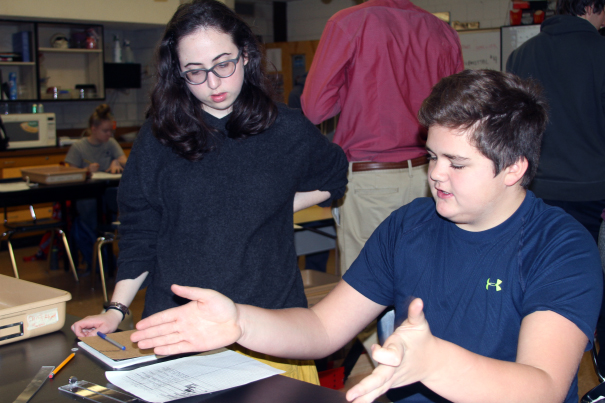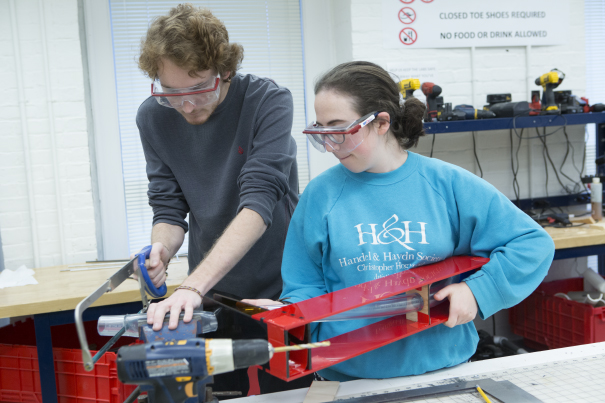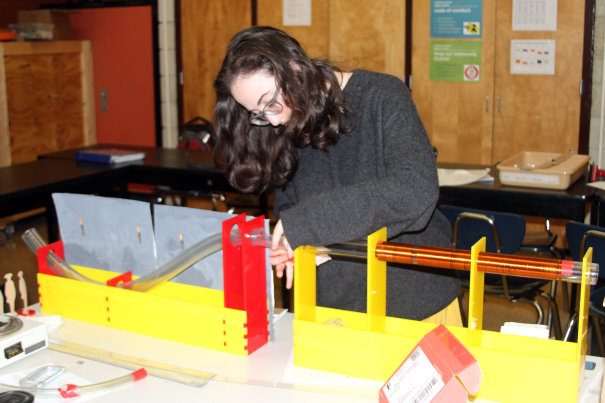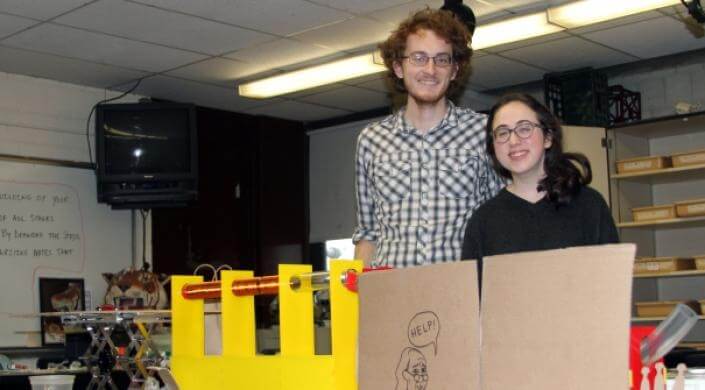News
Evan Weiner, A.B. '16, and Alona Bach, A.B. '16, developed this device to help eighth grade students learn about force and magnetism. (Photo by Adam Zewe/SEAS Communications)
Benjamin Franklin has been captured by the British. American forces have only one chance to rescue him from his maximum-security prison cell. How could they use the principles of force and magnetism to launch the famous patriot to freedom?
That's the scenario two Harvard students conceived to help a group of Cambridge eighth graders learn about the engineering design process.
Alona Bach, A.B. ’16, and Evan Weiner, A.B. ’16, students in the Harvard John A. Paulson School of Engineering and Applied Sciences course “Science, Engineering, and the Community” (ES 110), designed and built a device to test the engineering projects produced by several classes of eighth graders at the Kennedy Longfellow School in Cambridge. The eighth grade students, after completing a unit on electricity and magnetism, designed launchers that utilized a series of magnets to propel ball bearings.

Alona Bach quizzes eighth grade student Simon Simpson about his team's launcher. (Photo by Adam Zewe/SEAS Communications.)
“A lot of students come into science and engineering classes with a misconception that what they are learning is totally static, boring, and obscure,” said Bach, a history of science concentrator. “We wanted to find a fun way to teach students about using forces to achieve a goal.”
Over the course of the term, the Harvard students worked closely with eighth grade science classes, providing tips, advice, and moral support as the middle schoolers completed each step of the engineering design process.
At the same time, Bach and Weiner were designing and building their project. They constructed a launch pad and a tube to project the ball bearings torward a wheeled Benjamin Franklin figure. The force of the collision propels Franklin along a laser-cut ramp, eventually vaulting the founding father over a pair of Redcoat guards and safely into a sandy landing zone.
The project proved to be a true learning experience for Bach and Weiner, who had little prior engineering experience. One of the biggest challenges of the design process was finding the optimal height and angle for the ramp, said Weiner, a human development and regenerative biology concentrator.

Bach and Weiner assemble a prototype of their project in the SEAS Active Learning Labs. (Photo by Adam Zewe/SEAS Communications.)
“In a typical class, a letter grade is all you have to worry about,” he said. “Here, the stakes are much higher. Letting down 80 eighth graders who are relying on us to learn about science and engineering is a much, much greater consequence.”
During the culmination of their engineering project, the eighth grade students used Bach and Weiner’s creation to test their launchers. The students measured the distance Franklin traveled to determine which launcher was able to propel the ball bearing with the most force.
It was rewarding for Bach and Weiner to be able to help the students learn about force and magnetism. The challenges the Harvard students encountered while completing their project also served as a teachable moment for the eighth graders. The original plan included a sensor to calculate the force of impact when the ball bearings struck Franklin, but Bach and Weiner were forced to remove that element so they could meet the school’s deadline.

Bach assembles the final project in the eighth grade science classroom at Kennedy Longfellow School. (Photo by Adam Zewe/SEAS Communications.)
“Seeing how we had to change our design and tighten the scope is an important lesson for these students,” Bach said. “It shows them the realities of how the engineering design process works.”
Watching the students get excited about engineering made all those design and construction difficulties well worth it, Weiner said. While the project taught him a great deal about the day-to-day challenges faced by middle school teachers, it also gave him a new appreciation for the complexities of engineering design.
“One of the things I hope students take away from this course is that engineering design is a process,” said instructor Vinothan Manoharan, Wagner Family Professor of Chemical Engineering and Professor of Physics. “It requires creativity and planning in addition to technical skills. And, just like the scientific method, it’s a process that anyone—not just engineering majors and certainly not just college students—can and should learn.”
Engineering Project description
Evan Weiner explains how Benjamin Franklin will be launched to freedom.
Cutting-edge science delivered direct to your inbox.
Join the Harvard SEAS mailing list.
Press Contact
Adam Zewe | 617-496-5878 | azewe@seas.harvard.edu
